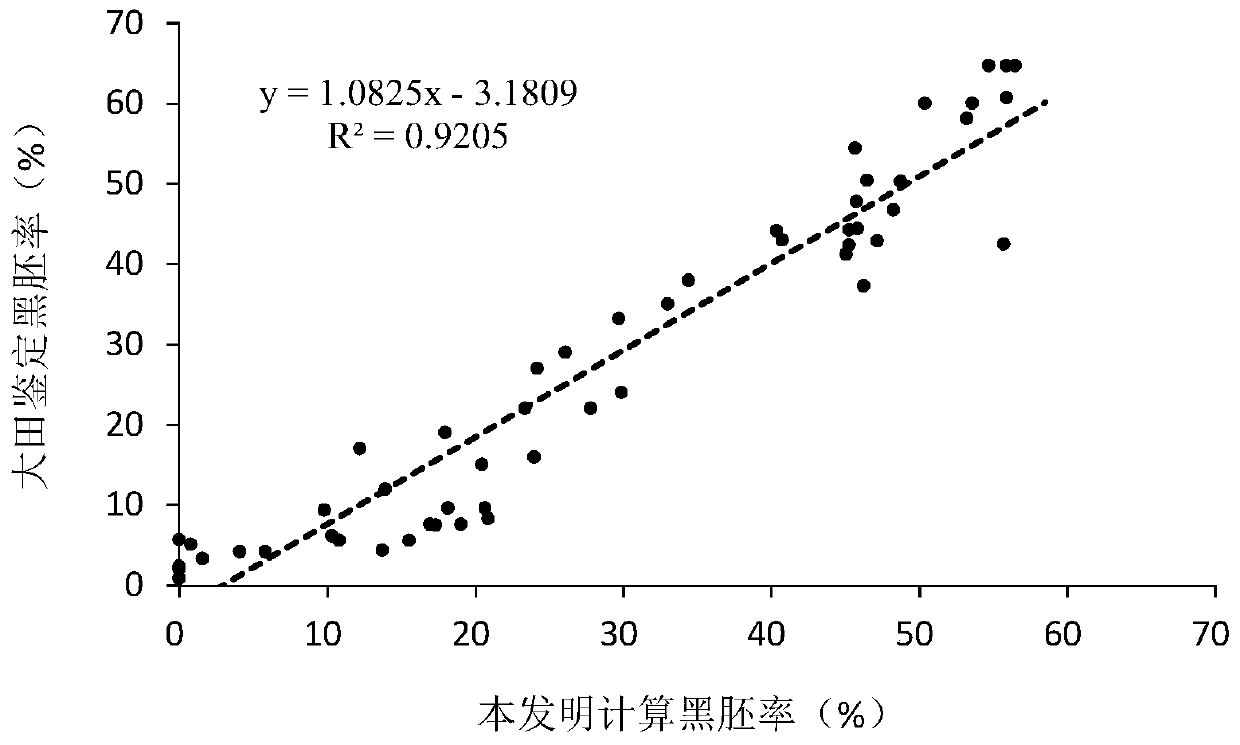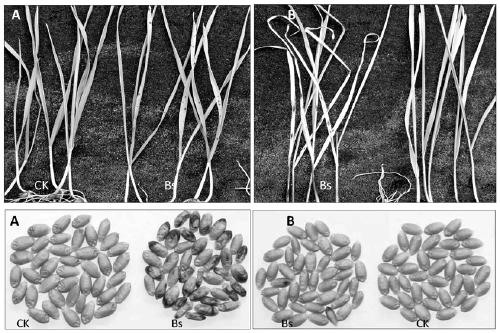Method for indoor quick recognition of wheat resistance to wheat root rot Umbilical Verticillium chlamydosporium black embryo disease
A technology of wheat root rot and Helmintheroides flatus, applied in the direction of microorganism-based methods, seed and rhizome treatment, botanical equipment and methods, etc., can solve the problems of laborious results, instability, time-consuming, etc., and improve efficiency and time Short, the effect of improving accuracy and reliability
- Summary
- Abstract
- Description
- Claims
- Application Information
AI Technical Summary
Problems solved by technology
Method used
Image
Examples
Embodiment 1
[0057] In the winter of 2016, using the method of the present invention for quickly identifying the resistance of wheat to B.sorokiniana black germ disease, 54 wheat lines harvested in Xingyang were identified for their resistance to black germ disease. The detailed steps are as follows:
[0058] a, surface sterilization of wheat seeds: select 54 healthy and plump wheat seeds of 54 wheat lines and soak them in 70% (volume ratio) alcohol for 2 minutes, then rinse with sterilized distilled water for 3 times, and shake gently for 5 seconds after adding distilled water each time Bell, so that the alcohol remaining on the surface of the seeds is fully dissolved in water to prevent alcohol from inhibiting the germination of wheat seeds;
[0059]b. Cultivation of wheat seedlings: put the wheat seeds after surface sterilization in step a in a petri dish with a diameter of 9 cm, and add 2 layers of sterilized filter paper and 4 mL of sterilized distilled water in advance in each petri d...
Embodiment 2
[0073] Using the method for quickly identifying the resistance of wheat to B.sorokiniana black germ disease in the laboratory of the present invention, 10 disease-resistant wheat lines were identified for 3 consecutive years, and compared with the field identification results. The detailed steps are as follows:
[0074] a, surface sterilization of wheat seeds: choose healthy, plump wheat seeds and immerse in 70% (volume ratio) alcohol for 2 minutes, then rinse 3 times with sterilized distilled water, shake gently for 5 seconds after adding distilled water each time, let The alcohol remaining on the surface of the seeds is fully soluble in water to prevent the alcohol from inhibiting the germination of wheat seeds;
[0075] b. Cultivation of wheat seedlings: put the wheat seeds after surface sterilization in step a in a petri dish with a diameter of 9 cm, and add 2 layers of sterilized filter paper and 4 mL of sterilized distilled water in advance in each petri dish, each Place...
Embodiment 3
[0089] Using the indoor rapid identification method of the present invention for the resistance of wheat to B.sorokiniana black embryo disease, in March 2018, 2 disease-resistant strains were identified from 10 F4 and F5 high-generation lines, and field hybridization was carried out in April, compared with field identification , do hybridization one year in advance to improve breeding efficiency, the detailed steps are as follows:
[0090] a. Surface sterilization of wheat seeds: select 10 F 4 with F 5The healthy and plump seeds of the high-generation wheat line were soaked in 70% (volume ratio) alcohol for 2 minutes, then rinsed with sterilized distilled water for 3 times, and shook gently for 5 seconds after adding distilled water each time, so that the alcohol remaining on the surface of the seeds was fully Soluble in water to prevent alcohol from inhibiting the germination of wheat seeds;
[0091] b. Cultivation of wheat seedlings: put the wheat seeds after surface steri...
PUM
 Login to View More
Login to View More Abstract
Description
Claims
Application Information
 Login to View More
Login to View More - Generate Ideas
- Intellectual Property
- Life Sciences
- Materials
- Tech Scout
- Unparalleled Data Quality
- Higher Quality Content
- 60% Fewer Hallucinations
Browse by: Latest US Patents, China's latest patents, Technical Efficacy Thesaurus, Application Domain, Technology Topic, Popular Technical Reports.
© 2025 PatSnap. All rights reserved.Legal|Privacy policy|Modern Slavery Act Transparency Statement|Sitemap|About US| Contact US: help@patsnap.com



